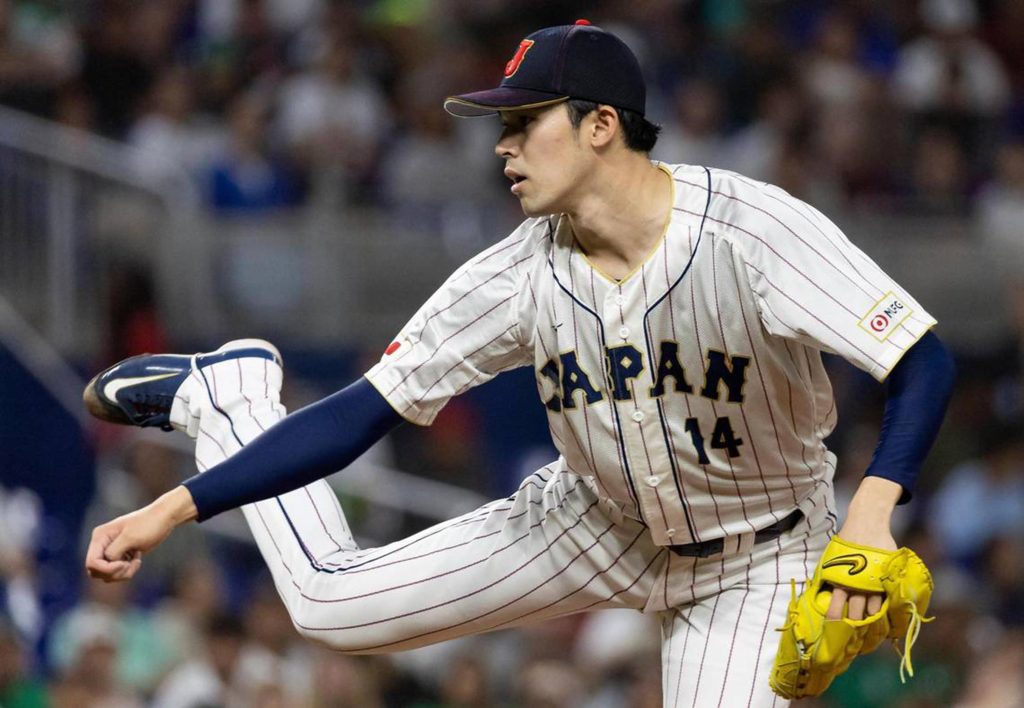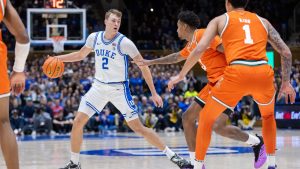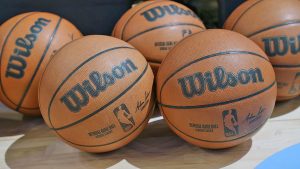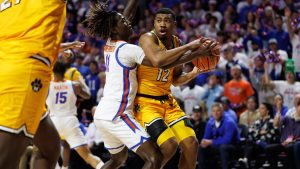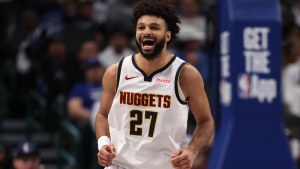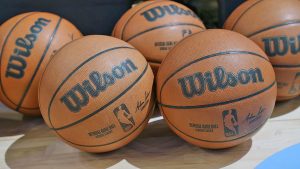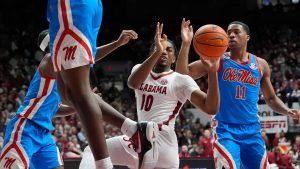The overwhelming majority of international amateur free agents are Latin American teenagers, but once in a blue moon, a player such as Sasaki makes the leap and upsets the system.
Editor’s note: This piece was originally published on Nov. 21, 2024. The 2025 international signing window opens on Jan. 15, 2025, and Roki Sasaki has until Jan. 23 to choose an MLB team.
Roki Sasaki’s impending MLB arrival should be cause for complete and total celebration. The 23-year-old Japanese phenom will immediately become one of the game’s must-see players. Whichever team signs him will have itself a potential frontline starter for the next six seasons. And Sasaki, as talented a young hurler as we’ve ever seen, will get to test his abilities at the highest level.
Unfortunately, there’s also a much darker side to the story. And it has very little to do with Sasaki himself.
Sasaki, as a non-American, non-Canadian player under the age of 25, will enter stateside baseball as part of international amateur free agency. The international market is an intricate, often unsavory world in which the overwhelming majority of players involved are Latin American teenagers. It is also an incredibly fragile ecosystem, one built upon handshake agreements and verbal promises. That means Sasaki’s entrance into the market has the potential to upend much of the 2025 international signing class, leaving a tornado of mayhem in its wake.
There remains a small chance that Sasaki will sign within the 2024 international window, which ends Dec. 15 — that would greatly simplify this process — but commissioner Rob Manfred told reporters Wednesday that he expects Sasaki to sign in the new year. That’s because his Japanese team, the Chiba Lotte Marines, will receive more money by making him available in 2025.
But to understand how Sasaki’s MLB arrival could throw the international amateur market into disarray, it’s vital to first understand how the system works.
Each year, all 30 MLB teams have a fixed amount of money that they can spend on signing bonuses for international amateur players, known colloquially as the “bonus pool.” The overwhelming majority of those players are Latin American teenagers, but once in a blue moon, a player such as Sasaki or Shohei Ohtani — an established professional from a foreign league who happens to be under the age of 25 — makes the leap and upsets the system.
The size of each team’s annual budget depends on (1) a club’s market size and (2) whether the club signed a high-priced free agent who received a qualifying offer in the preceding year. For the upcoming 2025 window, the Dodgers and Giants have the smallest bonus pool size, at $5,146,200, while an octet of teams share the largest sum, at $7,555,500.
But while teams cannot officially sign players in the 2025 class until Jan. 15, most amateurs have had verbal agreements in place for years, even though such “early deals” are technically against the rules. In other words, many MLB teams have already allocated their bonus budgets for the upcoming window.
Which makes Roki Sasaki — a worthwhile, unexpected cost for the team that signs him — an agent of chaos.
Sasaki’s decision to come to MLB now and not two years from now, when he would be a traditional free agent available to the highest bidder, suggests that maxing out his earnings is far from his top priority. The 23-year-old right hander is set to forgo at least $100 million. However, Sasaki isn’t going to sign for free, and there’s certainly a chance that the difference between $2.5 million and $5 million matters in the end.
As a result, and because all deals for the 2025 amateur window are, for now, only verbal, a team interested in Sasaki is incentivized to renege or rework any big-ticket agreements currently in place to free up bonus money for the Japanese flamethrower.
Here’s a theoretical example. One of the consensus top players in the class is a Dominican shortstop named Elian Peña, who has a verbal agreement with the New York Mets for a bonus north of $4 million. If the Mets think they have a strong chance at Sasaki and believe a few extra million in bonus money could make the difference, they could go to Peña’s representation and try to push down his agreed-upon bonus number.
Peña’s reps, who under the current system have little leverage, could do one of two things: accept a reworked deal from the Mets or reopen negotiations with other teams. But while option No. 2 could recoup more money, that money might not be available anywhere. Remember, most teams have already allocated most of their budget.
This is where things, according to sources familiar with the international market, could get even more complicated and chaotic.
Teams not seriously involved in the Sasaki sweepstakes, knowing that talented amateurs could reenter the market at the last minute, might attempt to renegotiate verbal deals of their own in order to swoop in on those discarded players. That could create a disastrous domino effect in which clubs and players are attempting to rework deals at the 11th hour in a tumultuous, frantic game of musical chairs — all because Sasaki, a pitcher with nearly 400 career innings thrown in the world’s second-best league, somehow falls into the same category as a yet-to-be-paid 16-year-old.
Others were skeptical that Sasaki’s arrival would create such a massive ripple effect, citing the importance of maintaining relationships with the trainers and agents who work with most of Latin America’s top amateurs. A team backing out of a deal at the last minute could create lasting discord with one or more of the region’s top power brokers.
There’s also a chance that Sasaki, having already left so much money on the table, won’t be overly concerned with his final bonus amount, instead prioritizing the team with which he feels most comfortable.
Sources indicated that the order of operations around Sasaki and any cutting of bonuses remains up in the air. It’s unclear whether teams will preemptively renegotiate deals before Jan. 15, the first day signings can be finalized, or wait until the fallout from Sasaki’s signing. But no matter the sequence, it’s a near certainty that at least one unfortunate amateur is going to end up with a smaller bonus because of Sasaki’s odd fit within the system.
The problem with the entire dynamic is that Sasaki and amateurs seven years his junior are lumped into the same structure. Sasaki will spend the entirety of 2025 in the major leagues; his fellow 2025 signees likely won’t debut until 2030 at the earliest. Sasaki could receive Cy Young votes next year. Most international amateurs will spend 2025 in the Dominican Summer League, the lowest level of professional affiliated baseball.
The only other precedent here involves soon-to-be three-time MVP Shohei Ohtani, who made the leap across the Pacific after the 2017 season. But Ohtani’s entrance into the market did not create a whirlwind of chaos in Latin America because (1) his arrival was less of a surprise than Sasaki’s and (2) the signing deadline at the time was in July, not January, meaning Ohtani showed up in the middle of the fiscal year. Even so, Ohtani’s involvement in the international amateur system, a system meant for players of an altogether different type, didn’t make much sense at the time.
And since then, that problem has not been fixed. In fact, it has gotten worse. One source called the system “a mess.” Another called it “broken.”
Most teams are negotiating with players as young as 12, even though a player must be at least 16 years old on signing day. Some of the amateurs set to sign in the upcoming window verbally agreed to deals as early as spring 2021, around the time that Sasaki debuted in NPB. Yet because of the current international bonus rules, Sasaki’s contract will take money out of someone else’s pocket — which is not at all his fault.
It’s like comparing apples and motorcycles. Every team would rather have Sasaki, particularly at such a low price, than any other player available in the 2025 class, and it’s not remotely close. Sasaski is the only proven commodity on offer.
As one evaluator put it: “I would much rather sign Sasaki than wait six years to figure out if [a player from the 2025 international class] is good.”
